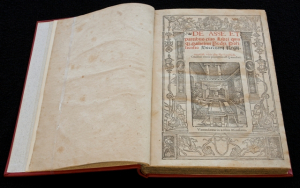The Art of Coin Collecting: How Old is it Really?
Feb 20th 2013

Figure 1: Guillaume Budé’s De Asse et Partibus
As a collector, you might not realize you’re part of a long line of collectors, a line that stretches into ancient history. You are participating in a tradition that was, for much of its history, called “the hobby of kings.”
Numismatics has always encompassed coin collecting, but coin collecting has not always necessarily been a part of numismatics. Numismatics is the official study and collection of currency and coins, but coin collecting in itself can simply be hoarding. For as long as coins have existed, people have stockpiled them. Sure, saving is not the same as “coin collecting,” but it is a collection process and eventually lead to what we now know as numismatics. Those early reserves are one of the reasons why we still have ancient coins today.
Ancient Persia had coins thousands of years ago and there were most certainly people who hoarded those coins to spend later. Today collectors are interested in the unique artistry, historic quality, and intrinsic value. Modern coin collecting values have certainly evolved since then. How did this change come about?
There is quite a lot of evidence from the archaeological and historical record to suggest that collecting for artistic value started early in modern history. According to Suetonius in his De vita Caesarum (The Lives of the Twelve Caesars) written in the first century A.D., the emperor Augustus sometimes presented old and exotic coins to friends and courtiers during festivals and other special occasions. This in itself suggests that Augustus collected the coins for their aesthetic value. And he did not just stick to coins featuring Caesars – he gave out coins of all kinds, including old pieces featuring ancient kings, and other foreign currencies.
One ancient coin that is still around today is called the “Widow’s Mite;” it is known technically as a Greek lepton, which was made famous by the New Testament parable in the Synoptic Gospels (Mark 12:41-44) in which Christ is reported to have said, “This poor widow has cast in more than all the rest . . . all she had." This coin was one of many that were still circulating during Christ’s lifetime, when Caesar Augustus ruled Rome.
Augustus wasn’t the only ancient guy collecting coins. Evidence also suggests that in the 12th and 13th centuries, the princes of Jazira (modern day Iraq, Syria, and Turkey) employed the Nestorian scholars and artisans to design and produce a magnificent series of coins with motifs based on past Ancient Greek and Roman coins. Some of these have so accurately rendered the details of the originals that even the inscriptions are “faithfully repeated.”
During the Renaissance, coin collecting became fashionable among members of the more privileged classes. The Italian poet and scholar Petrarch has been officially recognized as being coin-collecting’s first and most famous enthusiast. Because of Petrarch, many of Europe’s rulers and their heirs, as well as other distinguished members of nobility also began to keep collections of ancient coins. Some royal collectors included Pope Boniface VIII, Henry the IV of France, and Elector Joachim II of Brandenburg (who founded the Berlin Coin Cabinet, or Münzkabinett Berlin), which is still a museum today.
Petrarch is recognized as being the first official coin collector primarily because of a letter he sent discussing the vinediggers he often interacted with. These workmen asked him to buy or identify the rulers on old coins that they had found in the process of overturning the vineyards. Petrarch is also famous for giving a collection of Roman coins to the Holy Roman Emperor Charles IV in 1355.
Coin collecting was so popular among the noble classes that during the Renaissance, numismatics became known as “the hobby of kings.” Essentially, the Renaissance provided the ground work for what coin collecting has become today. Not only did it become exceedingly popular (especially among the wealthy classes, who could afford such a hobby), it also became the subject of study. In 1514, the first book on coins was published, titled De Asse et Partibus Eius (Which translates roughly from Latin as “The Sole and Parts Thereof”) by Guillaume Budé. This book is considered to be a pioneering study of Roman coins and numismatics, the most comprehensive book written on the subject at that time.
If we look closely at early coin collectors and numismatists, we see that their love of coins was not based on the literal value of the coin, but on the historical and artistic value. Although numismatics has evolved, it is evident that the quality of the coin, the artistic value, and the historical significance of coins are still of major importance to collectors.
Here at International Coins and Currency, we recognize that for you coin collectors out there, your hobby (or your profession) is equally as important and revered to you as it was to Caesar Augustus, Petrarch, or members of noble European societies. To be able to carry a tradition like this into the modern age is a task best left to you, the numismatists and the coin collectors.
Amanda Paulger-Foran, for ICCoin.com
